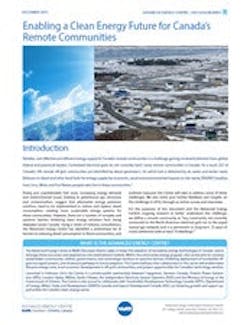Reliable, cost-effective and efficient clean energy supply for Canada’s remote communities is a challenge gaining increased attention from global, federal and provincial leaders. Centralized electrical grids do not currently reach many remote communities in Canada. As a result, 257 of Canada’s 292 remote off-grid communities are electrified by diesel generators1, for which fuel is delivered by air, water and winter roads. Reliance on diesel and other fossil fuels for energy supply has economic, social and environmental impacts on the nearly 200,000 Canadian, Inuit, Innu, Metis and First Nation peoples who live in these communities.
Rising and unpredictable fuel costs, increasing energy demand and environmental issues relating to greenhouse gas emissions and contamination, suggest that alternative energy provision solutions need to be implemented to reduce and replace diesel consumption, creating more sustainable energy systems for these communities. However, there are a number of complex and systemic barriers inhibiting clean energy solutions from being deployed across Canada. Using a series of industry consultations, the Advanced Energy Centre has identified a preliminary list of
barriers to reducing diesel consumption in these communities, and outlined measures the Centre will take to address some of these challenges. We also invite your further feedback and insights on this challenge in 2016, through an online survey and interviews.
For the purposes of this document and the Advanced Energy Centre’s ongoing research to better understand this challenge, we define a remote community as “any community not currently connected to the North-American electrical grid nor to the piped natural gas network; and is a permanent or long-term (5 years of more) settlement with at least 10 dwellings.”
